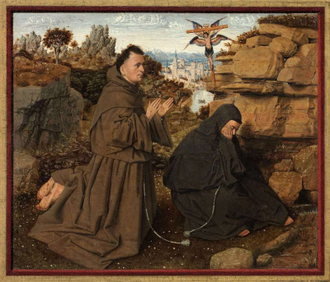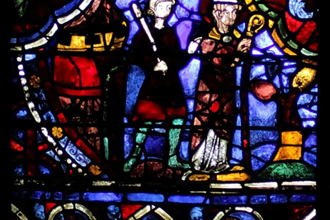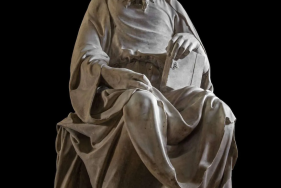Gospel in Art: Feast of Saint Francis of Assisi

Saint Francis of Assisi Receiving the Stigmata, by Jan van Eyck © Philadelphia Museum of Art
Source: Christian Art
Gospel of 4 October 2024
Matthew 11:28-30
Jesus said, 'Come to me, all you who labour and are overburdened, and I will give you rest. Shoulder my yoke and learn from me, for I am gentle and humble in heart, and you will find rest for your souls. Yes, my yoke is easy and my burden light.'
Reflection on the painting
Today we celebrate the Feast of Saint Francis of Assisi (1182-1226), who passed away on the evening of 3rd October 1226. Members of the Franciscan Order continue to commemorate his final hours through a service known as the "Transitus of St. Francis", which ran into the 4th of October, hence the date we celebrate the feast of St Francis on this day. The word transitus is Latin for "passing over," and it marks the moment of St Francis' transition from this earthly life to eternal life in heaven.
Unlike many medieval saints, Francis was neither particularly studious nor pious in his youth. Born into wealth, he enjoyed a lively and privileged social life among the upper classes, earning a reputation as being the life of the party. However, his carefree existence was interrupted during a war with a rival Italian city-state when Francis was captured and imprisoned. This experience forced him to confront more serious, spiritual thoughts, further intensified by a recurring dream suggesting that his true 'army' was not of this world. Upon returning to Assisi in 1205 due to illness, Francis began to embrace a life of voluntary poverty and simplicity.
Three pivotal moments deeply confirmed to Francis that he was following God's will. In Assisi, he overcame his revulsion of disease by kissing the hand of a leper, an act of profound humility and compassion. Shortly after, while on a pilgrimage to Rome, he gave away his money at Saint Peter's tomb and exchanged clothes with a beggar, embracing poverty fully. Upon returning home, Francis had a vision in which Christ instructed him: "Go, Francis, and repair my house, which as you see is falling into ruin." His close imitation of Christ culminated in the miraculous event of receiving the stigmata, Christ's wounds, on his own body in September 1224, a mark of his deep union with the Lord's sufferings.
This profound moment is captured in Jan van Eyck's depiction of Francis receiving the stigmata during a forty-day fast in the wilderness. The painting portrays the wounds on Francis's hands and feet with striking realism; the deep cuts contrast with his serene and peaceful expression. Above him, a seraph holds a floating cross, symbolising the divine nature of the event. The rocky landscape includes a Flemish city (possibly Bruges) in the distance. The painting is tiny, only 12 x 15cm. (5 x 5 3/4 inches), suggesting that it was intended as a portable, private object of devotion.
LINKS
Gospel in Art: https://christian.art/
Today's Reflection: https://christian.art/daily-gospel-reading/matthew-11-28-30-2024-2/


















